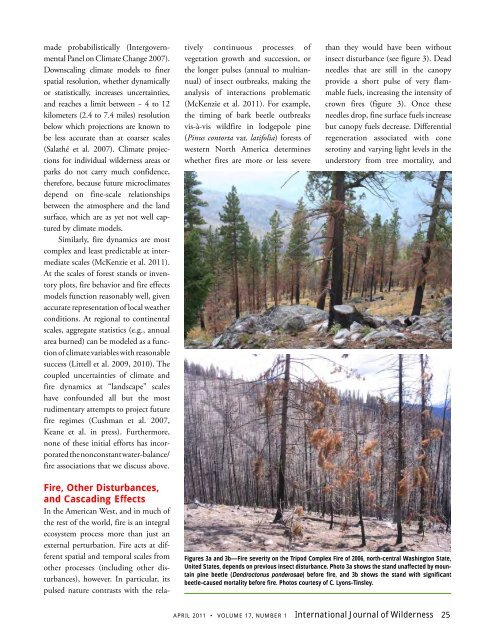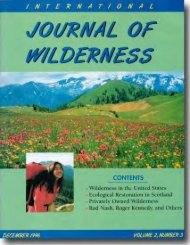Download April 2011 PDF - International Journal of Wilderness
Download April 2011 PDF - International Journal of Wilderness
Download April 2011 PDF - International Journal of Wilderness
You also want an ePaper? Increase the reach of your titles
YUMPU automatically turns print PDFs into web optimized ePapers that Google loves.
made probabilistically (Intergovernmental<br />
Panel on Climate Change 2007).<br />
Downscaling climate models to finer<br />
spatial resolution, whether dynamically<br />
or statistically, increases uncertainties,<br />
and reaches a limit between ~ 4 to 12<br />
kilometers (2.4 to 7.4 miles) resolution<br />
below which projections are known to<br />
be less accurate than at coarser scales<br />
(Salathé et al. 2007). Climate projections<br />
for individual wilderness areas or<br />
parks do not carry much confidence,<br />
therefore, because future microclimates<br />
depend on fine-scale relationships<br />
between the atmosphere and the land<br />
surface, which are as yet not well captured<br />
by climate models.<br />
Similarly, fire dynamics are most<br />
complex and least predictable at intermediate<br />
scales (McKenzie et al. <strong>2011</strong>).<br />
At the scales <strong>of</strong> forest stands or inventory<br />
plots, fire behavior and fire effects<br />
models function reasonably well, given<br />
accurate representation <strong>of</strong> local weather<br />
conditions. At regional to continental<br />
scales, aggregate statistics (e.g., annual<br />
area burned) can be modeled as a function<br />
<strong>of</strong> climate variables with reasonable<br />
success (Littell et al. 2009, 2010). The<br />
coupled uncertainties <strong>of</strong> climate and<br />
fire dynamics at “landscape” scales<br />
have confounded all but the most<br />
rudimentary attempts to project future<br />
fire regimes (Cushman et al. 2007,<br />
Keane et al. in press). Furthermore,<br />
none <strong>of</strong> these initial efforts has incorporated<br />
the nonconstant water-balance/<br />
fire associations that we discuss above.<br />
Fire, Other Disturbances,<br />
and Cascading Effects<br />
In the American West, and in much <strong>of</strong><br />
the rest <strong>of</strong> the world, fire is an integral<br />
ecosystem process more than just an<br />
external perturbation. Fire acts at different<br />
spatial and temporal scales from<br />
other processes (including other disturbances),<br />
however. In particular, its<br />
pulsed nature contrasts with the rela-<br />
tively continuous processes <strong>of</strong><br />
vegetation growth and succession, or<br />
the longer pulses (annual to multiannual)<br />
<strong>of</strong> insect outbreaks, making the<br />
analysis <strong>of</strong> interactions problematic<br />
(McKenzie et al. <strong>2011</strong>). For example,<br />
the timing <strong>of</strong> bark beetle outbreaks<br />
vis-à-vis wildfire in lodgepole pine<br />
(Pinus contorta var. latifolia) forests <strong>of</strong><br />
western North America determines<br />
whether fires are more or less severe<br />
than they would have been without<br />
insect disturbance (see figure 3). Dead<br />
needles that are still in the canopy<br />
provide a short pulse <strong>of</strong> very flammable<br />
fuels, increasing the intensity <strong>of</strong><br />
crown fires (figure 3). Once these<br />
needles drop, fine surface fuels increase<br />
but canopy fuels decrease. Differential<br />
regeneration associated with cone<br />
serotiny and varying light levels in the<br />
understory from tree mortality, and<br />
Figures 3a and 3b—Fire severity on the Tripod Complex Fire <strong>of</strong> 2006, north-central Washington State,<br />
United States, depends on previous insect disturbance. Photo 3a shows the stand unaffected by mountain<br />
pine beetle (Dendroctonus ponderosae) before fire, and 3b shows the stand with significant<br />
beetle-caused mortality before fire. Photos courtesy <strong>of</strong> C. Lyons-Tinsley.<br />
APRIL <strong>2011</strong> VOLUME 17, NUMBER 1 <strong>International</strong> <strong>Journal</strong> <strong>of</strong> <strong>Wilderness</strong> 25










